⼯具栏
⼯具栏是应⽤程序中集成各种功能实现快捷键使⽤的⼀个区域。可以有多个,也可以没有,它并不是应⽤程序中必须存在的组件。它是⼀个可移动的组件,它的元素可以是各种窗⼝组件,它的元素通常以图标按钮的⽅式存在。如下图为⼯具栏的⽰意图:

创建⼯具栏
调⽤QMainWindow类的addToolBar()函数来创建⼯具栏,每增加⼀个⼯具栏都需要调⽤⼀次该函数。
如添加两个⼯具栏:
c++
#include "mainwindow.h"
#include "ui_mainwindow.h"
#include <QToolBar>
#include <QDebug>
MainWindow::MainWindow(QWidget *parent)
: QMainWindow(parent)
, ui(new Ui::MainWindow)
{
ui->setupUi(this);
//工具栏手动创建
QToolBar* toolBar = new QToolBar();
this->addToolBar(toolBar);
QAction* action1 = new QAction("保存");
toolBar->addAction(action1);
QAction* action2 = new QAction("打开");
toolBar->addAction(action2);
connect(action1, &QAction::triggered, this, &MainWindow::handle1);
connect(action2, &QAction::triggered, this, &MainWindow::handle2);
}
MainWindow::~MainWindow()
{
delete ui;
}
void MainWindow::handle1()
{
qDebug() << "handle1";
}
void MainWindow::handle2()
{
qDebug() << "handle2";
}使用QToolBar表示工具栏对象
一个窗口可以有多个工具栏,也可以没有
工具栏往往也可以手动移动位置
添加菜单栏,使用的是setMenuBar
添加工具栏,使用的是addToolBar
菜单栏只能有一个.重复设置,新的替换旧的(set就包含了"替换")
工具栏,可以有多个.重复设置,就会出现多个工具栏不包含"替换"

c++
action1->setIcon(QIcon(":/save.png"));
action2->setIcon(QIcon(":/new.png"));QAction如果出现在工具栏上,也会产生图标覆盖文本这样的情况
会以toolTip的方式来存在
鼠标悬停上去的时候,就会显示出一段提示信息
另外也可以手动设置这里的toolTip

c++
action1->setToolTip("点击这里保存文件");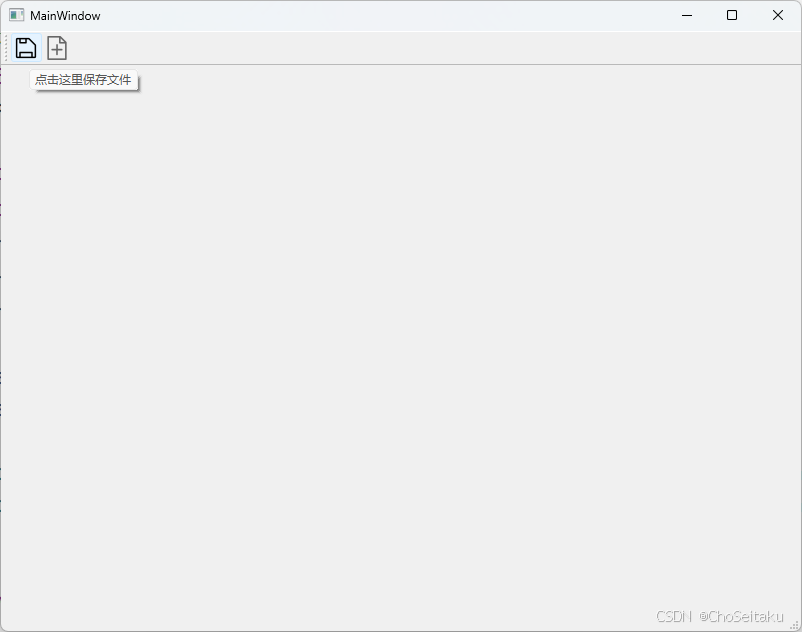
c++
#include "mainwindow.h"
#include "ui_mainwindow.h"
#include <QToolBar>
#include <QDebug>
MainWindow::MainWindow(QWidget *parent)
: QMainWindow(parent)
, ui(new Ui::MainWindow)
{
ui->setupUi(this);
//创建菜单栏
QMenuBar* menuBar = this->menuBar();
this->setMenuBar(menuBar);
//创建菜单
QMenu* menu = new QMenu("文件");
menuBar->addMenu(menu);
//工具栏手动创建
QToolBar* toolBar = new QToolBar();
this->addToolBar(toolBar);
QAction* action1 = new QAction("保存");
QAction* action2 = new QAction("打开");
action1->setToolTip("点击这里保存文件");
action1->setIcon(QIcon(":/save.png"));
action2->setIcon(QIcon(":/new.png"));
//菜单项放在工具栏中
toolBar->addAction(action1);
toolBar->addAction(action2);
//菜单项放在菜单中
menu->addAction(action1);
menu->addAction(action2);
connect(action1, &QAction::triggered, this, &MainWindow::handle1);
connect(action2, &QAction::triggered, this, &MainWindow::handle2);
}
MainWindow::~MainWindow()
{
delete ui;
}
void MainWindow::handle1()
{
qDebug() << "handle1";
}
void MainWindow::handle2()
{
qDebug() << "handle2";
}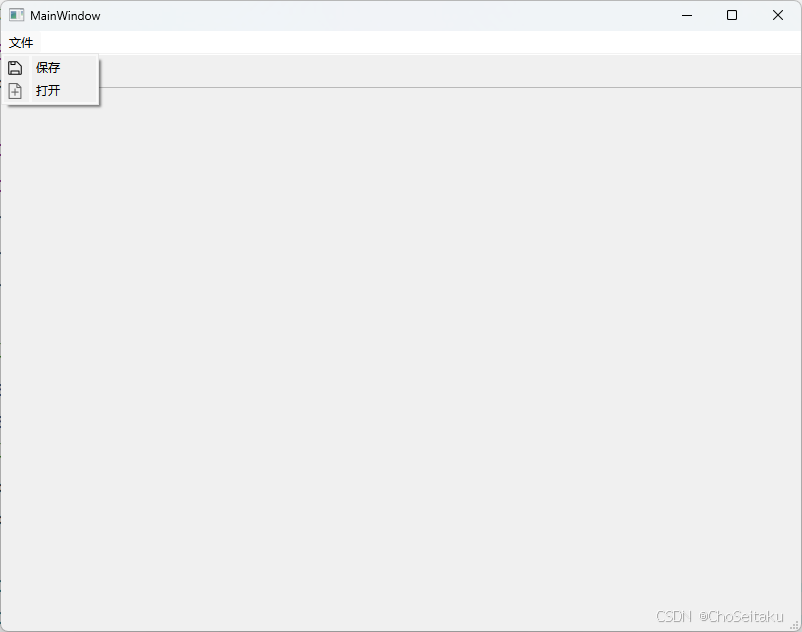
工具栏往往也是和菜单栏搭配使用的
工具栏中的QAction也可以出现在菜单中
如果一个QAction既是QMenu的子元素,又是QToolBar的子元素,释放的时候,是否会重复delete
只会释放一次,不会重复delete
设置停靠位置
⼯具栏停靠位置的设置有两种⽅式。⼀种是在创建⼯具栏的同时指定停靠的位置,另⼀种是通过QToolBar类提供的setAllowedAreas()函数来设置。
⽅式⼀:创建⼯具栏的同时指定其停靠的位置。
在创建⼯具栏的同时,也可以设置⼯具栏的位置,其默认位置是在窗⼝的最上⾯;如上述代码,默认在最上⾯显⽰。⼯具栏允许停靠的区域由QToolBar类提供的allowAreas()函数决定,其中可以设置的位置包括:
- 可以设置工具栏出现的初始位置(上下左右...)
- 可以设置工具栏允许停放到哪些边缘
- 可以设置工具栏是否允许浮动
- 可以设置工具栏是否可以移动
- Qt::LeftToolBarArea:停靠在左侧
- Qt::RightToolBarArea:停靠在右侧
- Qt::TopToolBarArea:停靠在顶部
- Qt::BottomToolBarArea:停靠在底部
- Qt::AllToolBarAreas:以上四个位置都可停靠
c++
#include "mainwindow.h"
#include "ui_mainwindow.h"
#include <QToolBar>
MainWindow::MainWindow(QWidget *parent)
: QMainWindow(parent)
, ui(new Ui::MainWindow)
{
ui->setupUi(this);
QToolBar* toolBar1 = new QToolBar();
QToolBar* toolBar2 = new QToolBar();
this->addToolBar(toolBar1);
this->addToolBar(toolBar2);
QAction* action1 = new QAction("动作1");
QAction* action2 = new QAction("动作2");
QAction* action3 = new QAction("动作3");
QAction* action4 = new QAction("动作4");
toolBar1->addAction(action1);
toolBar1->addAction(action2);
toolBar2->addAction(action3);
toolBar2->addAction(action4);
}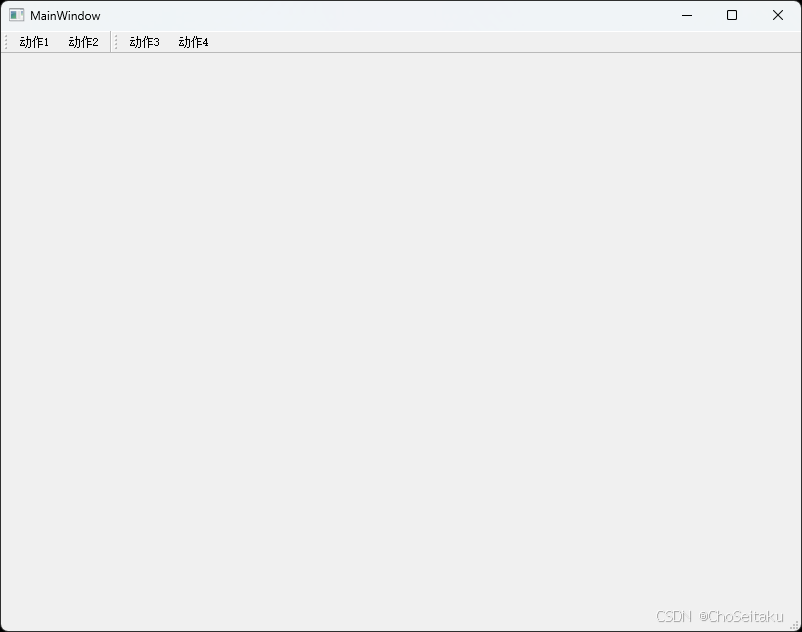
c++
#include "mainwindow.h"
#include "ui_mainwindow.h"
#include <QToolBar>
MainWindow::MainWindow(QWidget *parent)
: QMainWindow(parent)
, ui(new Ui::MainWindow)
{
ui->setupUi(this);
QToolBar* toolBar1 = new QToolBar();
QToolBar* toolBar2 = new QToolBar();
this->addToolBar(toolBar1);
this->addToolBar(Qt::LeftToolBarArea, toolBar2);
QAction* action1 = new QAction("动作1");
QAction* action2 = new QAction("动作2");
QAction* action3 = new QAction("动作3");
QAction* action4 = new QAction("动作4");
toolBar1->addAction(action1);
toolBar1->addAction(action2);
toolBar2->addAction(action3);
toolBar2->addAction(action4);
}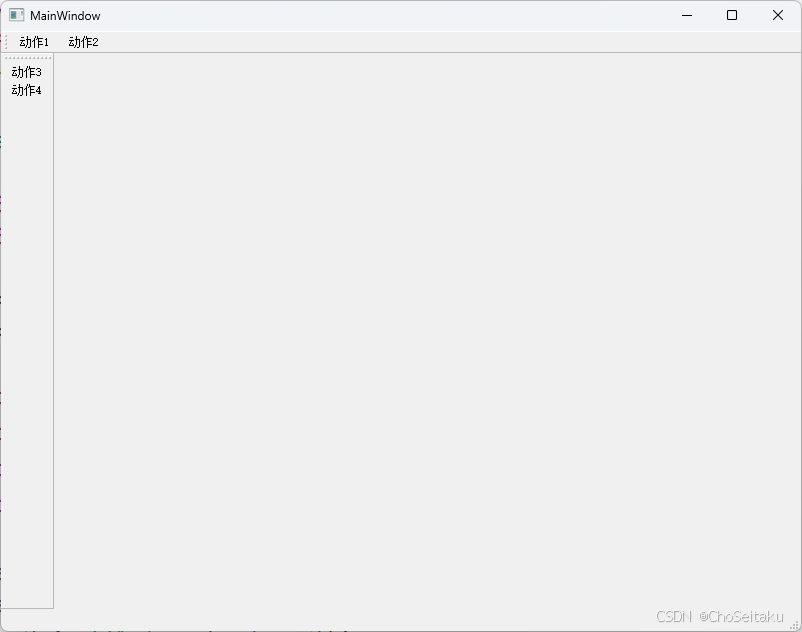
⽅式⼆:使⽤QToolBar类提供的setAllowedAreas()函数设置停靠位置。如下⽰例:
c++
QToolBar* toolBar1 = new QToolBar();
QToolBar* toolBar2 = new QToolBar();
this->addToolBar(toolBar1);
this->addToolBar(Qt::LeftToolBarArea, toolBar2);
//允许在左右侧停靠
toolBar2->setAllowedAreas(Qt::LeftToolBarArea | Qt::RightToolBarArea);在创建⼯具栏的同时指定其停靠的位置,指的是程序运⾏时⼯具栏默认所在的位置;⽽使⽤setAllowedAreas()函数设置停靠位置,指的是⼯具栏允许其所能停靠的位置。
设置浮动属性
⼯具栏的浮动属性可以通过 QToolBar类 提供的setFloatable()函数 来设置。setFloatable()函数原型为:
void setFloatable(bool floatable)
参数:
true:浮动
false:不浮动
c++
QToolBar* toolBar1 = new QToolBar();
QToolBar* toolBar2 = new QToolBar();
this->addToolBar(toolBar1);
this->addToolBar(Qt::LeftToolBarArea, toolBar2);
//只允许停靠在左侧或者右侧
toolBar2->setAllowedAreas(Qt::LeftToolBarArea | Qt::RightToolBarArea);
//设置不允许浮动
toolBar2->setFloatable(false);设置移动属性
设置⼯具栏的移动属性可以通过QToolBar类提供的setMovable()函数来设置。setMovable()函数原型为:
void setMovable(bool movable)
参数:
true:移动
false:不移动
说明:若设置⼯具栏为不移动状态,则设置其停靠位置的操作就不会⽣效,所以设置⼯具栏的移动属性类似于总开关的效果
c++
QToolBar* toolBar1 = new QToolBar();
QToolBar* toolBar2 = new QToolBar();
this->addToolBar(toolBar1);
this->addToolBar(Qt::LeftToolBarArea, toolBar2);
//只允许停靠在左侧或者右侧
toolBar2->setAllowedAreas(Qt::LeftToolBarArea | Qt::RightToolBarArea);
//设置不允许浮动
toolBar2->setFloatable(false);
//设置不允许移动
toolBar2->setMovable(false);
综合⽰例
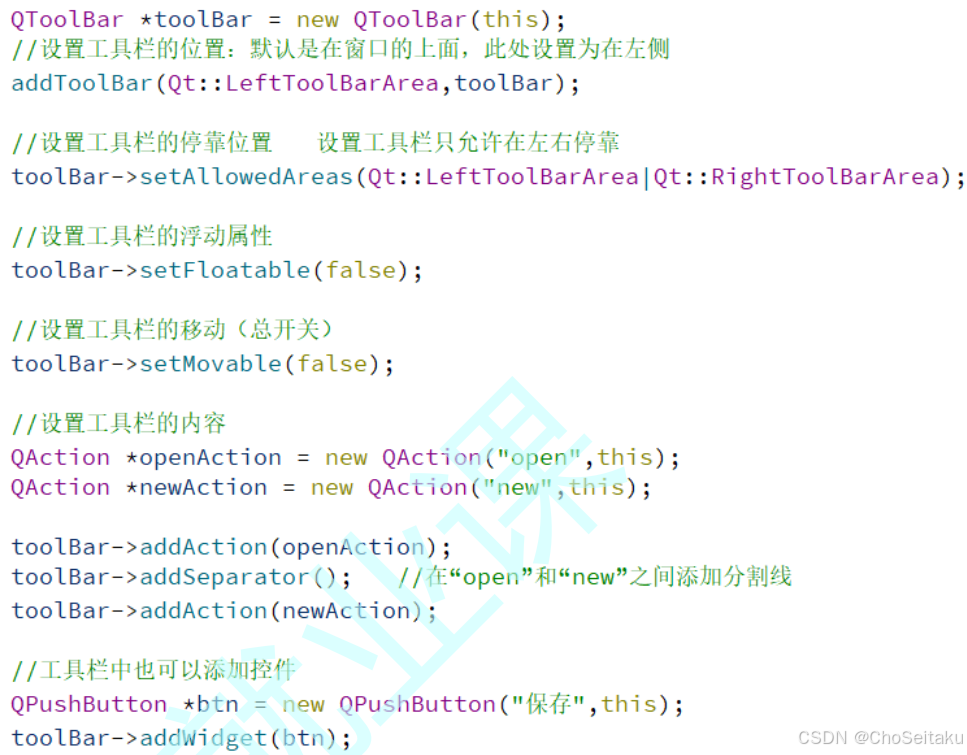
状态栏
状态栏是应⽤程序中输出简要信息的区域。⼀般位于主窗⼝的最底部,⼀个窗⼝中最多只能有⼀个状态栏。在Qt中,状态栏是通过QStatusBar类来实现的。在状态栏中可以显⽰的消息类型有:
- 实时消息:如当前程序状态
- 永久消息:如程序版本号,机构名称
- 进度消息:如进度条提⽰,百分百提⽰
状态栏的创建
状态栏的创建是通过QMainWindow类提供的statusBar()函数来创建;⽰例如下:
c++
#include "mainwindow.h"
#include "ui_mainwindow.h"
MainWindow::MainWindow(QWidget *parent)
: QMainWindow(parent)
, ui(new Ui::MainWindow)
{
ui->setupUi(this);
//存在就获取,不存在就创建
QStatusBar* statusBar = this->statusBar();
//如果状态栏没有被创建,这样的设置是必要的
//如果状态栏已经在窗口中存在,这样设置的意义不大,但也没有副作用,仍然保留
this->setStatusBar(statusBar);
}在状态栏中显⽰实时消息
在状态栏中显⽰实时消息是通过showMessage()函数来实现,⽰例如下:
c++
//显示一个临时的信息
statusBar->showMessage("这是一个状态消息", 3000);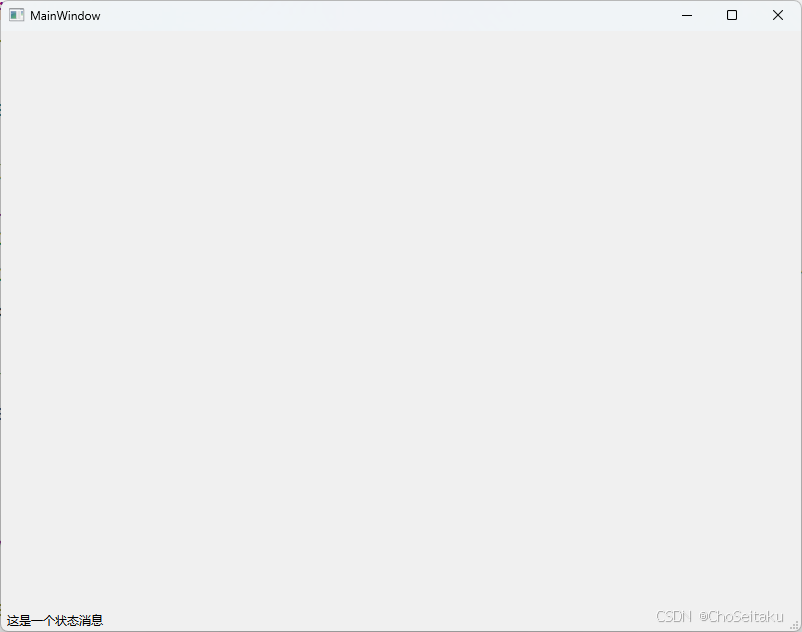
3秒之后,消息自动消失
通过showMessage可以在状态栏中显示一个文本.
此时这个文本存在的时间可以自定义.
timeout参数是一个单位为ms的时间,如果timeout为0(不填),消息就会持久存在
在状态栏中显⽰永久消息
在状态栏中可以显⽰永久消息,此处的永久消息是通过标签来显⽰的;⽰例如下:

addWidget从左往右添加.
addPermanentWidget从右往左添加.
c++
#include "mainwindow.h"
#include "ui_mainwindow.h"
#include <QLabel>
MainWindow::MainWindow(QWidget *parent)
: QMainWindow(parent)
, ui(new Ui::MainWindow)
{
ui->setupUi(this);
//存在就获取,不存在就创建
QStatusBar* statusBar = this->statusBar();
//如果状态栏没有被创建,这样的设置是必要的
//如果状态栏已经在窗口中存在,这样设置的意义不大,但也没有副作用,仍然保留
this->setStatusBar(statusBar);
//给状态栏添加子控件
QLabel* label = new QLabel("这是一个QLabel");
statusBar->addWidget(label);
}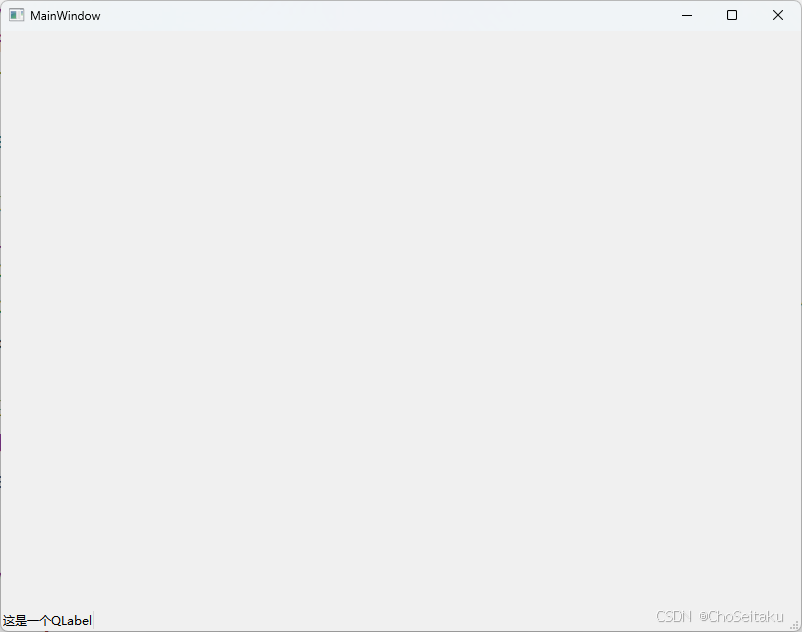
c++
//给状态栏添加子控件
QLabel* label = new QLabel("这是一个QLabel");
statusBar->addWidget(label);
QLabel* label2 = new QLabel("这是另一个QLabel");
statusBar->addPermanentWidget(label2);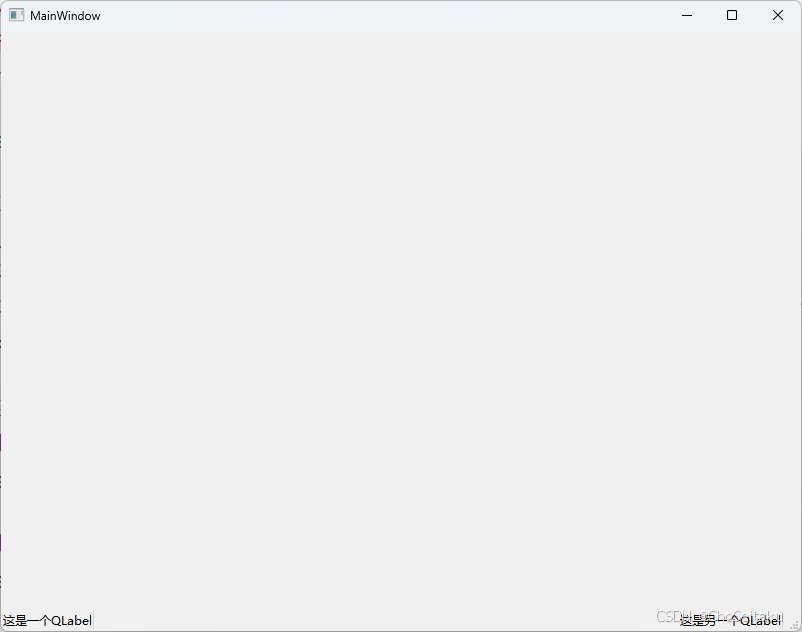
拉伸系数
c++
//给状态栏添加子控件
QLabel* label = new QLabel("这是一个QLabel");
statusBar->addWidget(label, 1);
QLabel* label2 = new QLabel("这是另一个QLabel");
statusBar->addWidget(label2, 2);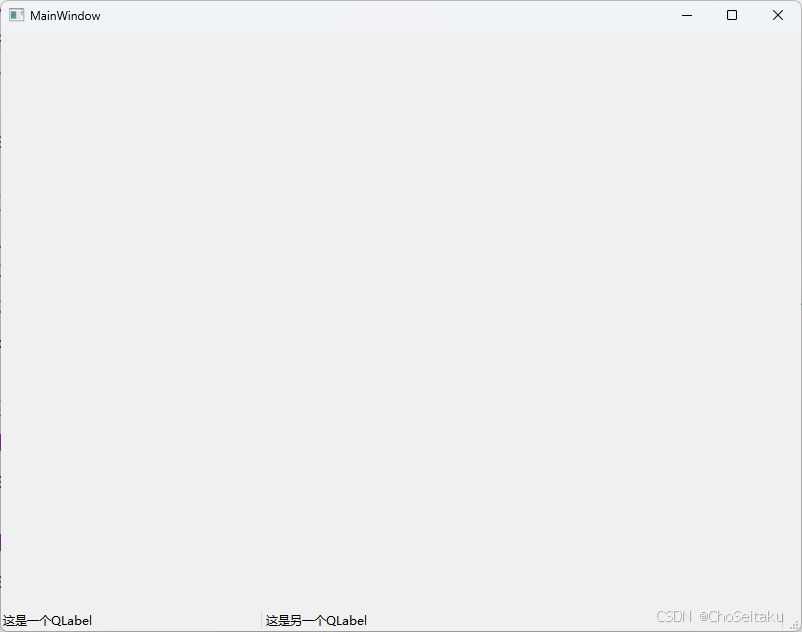
添加进度条
c++
#include "mainwindow.h"
#include "ui_mainwindow.h"
#include <QLabel>
#include <QProgressBar>
MainWindow::MainWindow(QWidget *parent)
: QMainWindow(parent)
, ui(new Ui::MainWindow)
{
ui->setupUi(this);
//存在就获取,不存在就创建
QStatusBar* statusBar = this->statusBar();
//如果状态栏没有被创建,这样的设置是必要的
//如果状态栏已经在窗口中存在,这样设置的意义不大,但也没有副作用,仍然保留
this->setStatusBar(statusBar);
//给状态栏添加子控件
QLabel* label = new QLabel("这是一个QLabel");
statusBar->addWidget(label);
QProgressBar* progressBar = new QProgressBar();
progressBar->setRange(0, 100);
progressBar->setValue(50);
statusBar->addWidget(progressBar);
}
添加按钮
c++
QPushButton* button = new QPushButton("按钮");
statusBar->addPermanentWidget(button);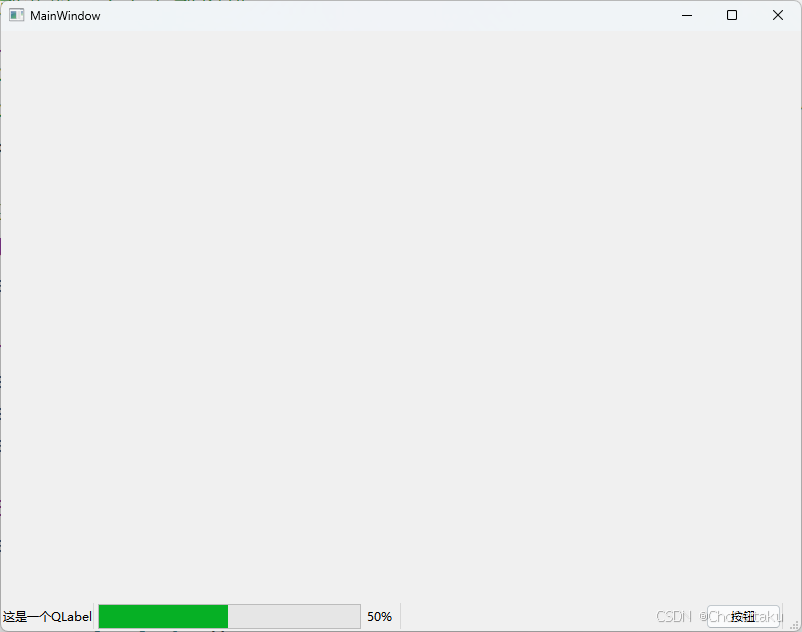
浮动窗⼝
在Qt中,浮动窗⼝也称之为铆接部件。浮动窗⼝是通过QDockWidget类来实现浮动的功能。浮动窗⼝⼀般是位于核⼼部件的周围,可以有多个。
浮动窗⼝的创建
浮动窗⼝的创建是通过QDockWidget类提供的构造⽅法QDockWidget()函数动态创建的;⽰例如下:
c++
#include "mainwindow.h"
#include "ui_mainwindow.h"
#include <QDockWidget>
MainWindow::MainWindow(QWidget *parent)
: QMainWindow(parent)
, ui(new Ui::MainWindow)
{
ui->setupUi(this);
//给主窗口添加一个子窗口
QDockWidget* dockWidget = new QDockWidget();
//使用addDockWidget把浮动窗口加入到子窗口中
this->addDockWidget(Qt::LeftDockWidgetArea, dockWidget);
}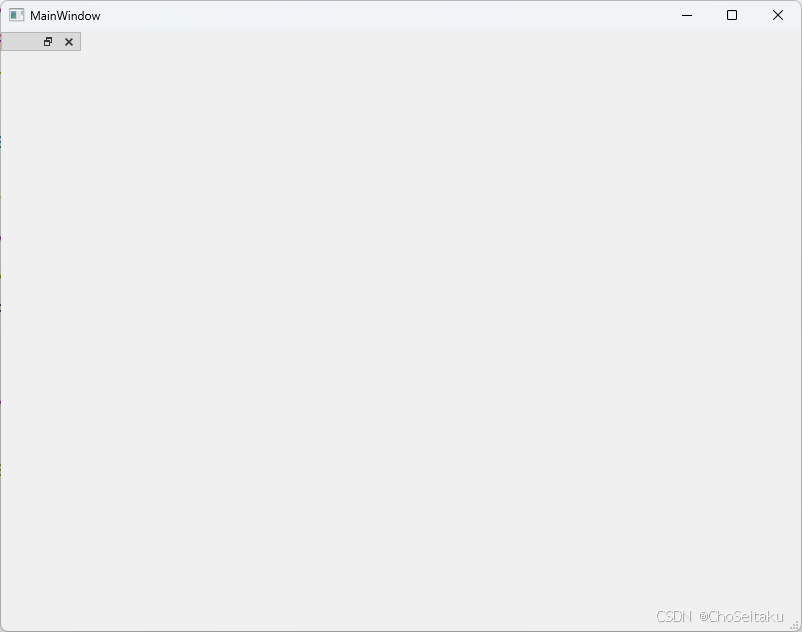
c++
//设置窗口标题
dockWidget->setWindowTitle("这是一个浮动窗口");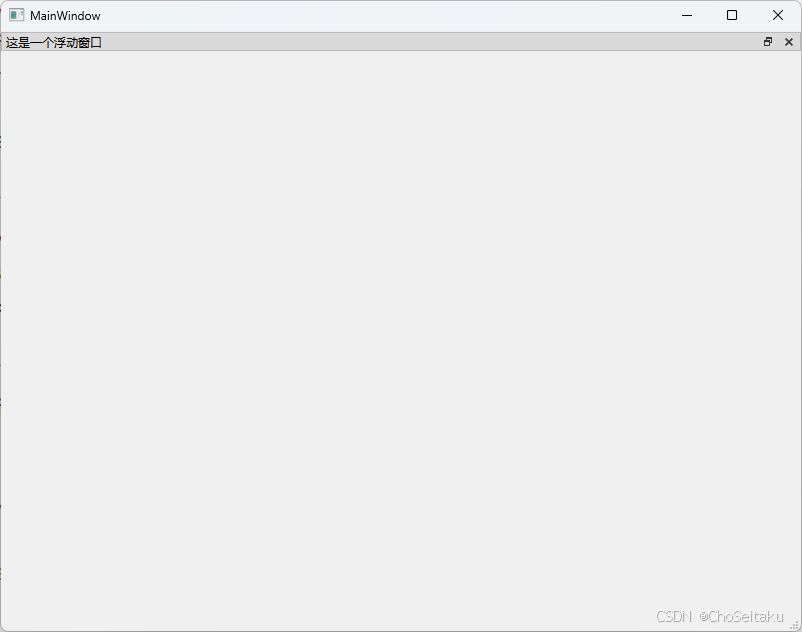
c++
#include "mainwindow.h"
#include "ui_mainwindow.h"
#include <QDockWidget>
#include <QLabel>
#include <QPushButton>
#include <QVBoxLayout>
MainWindow::MainWindow(QWidget *parent)
: QMainWindow(parent)
, ui(new Ui::MainWindow)
{
ui->setupUi(this);
//给主窗口添加一个子窗口
QDockWidget* dockWidget = new QDockWidget();
//使用addDockWidget把浮动窗口加入到子窗口中
this->addDockWidget(Qt::LeftDockWidgetArea, dockWidget);
//设置窗口标题
dockWidget->setWindowTitle("这是一个浮动窗口");
//给浮动窗口内部,添加一些其他控件
//不能直接给浮动窗口添加子控件,而是要单独创建一个QWidget,把要添加的控件加入到QWidget中
//然后再把这个QWidget设置到dockWidget中
QWidget* container = new QWidget();
dockWidget->setWidget(container);
//创建布局管理器,把布局管理器设置到QWidget中
QVBoxLayout* layout = new QVBoxLayout;
container->setLayout(layout);
//创建其他控件
QLabel* label = new QLabel("这是一个QLabel");
QPushButton* button = new QPushButton("这是按钮");
layout->addWidget(label);
layout->addWidget(button);
}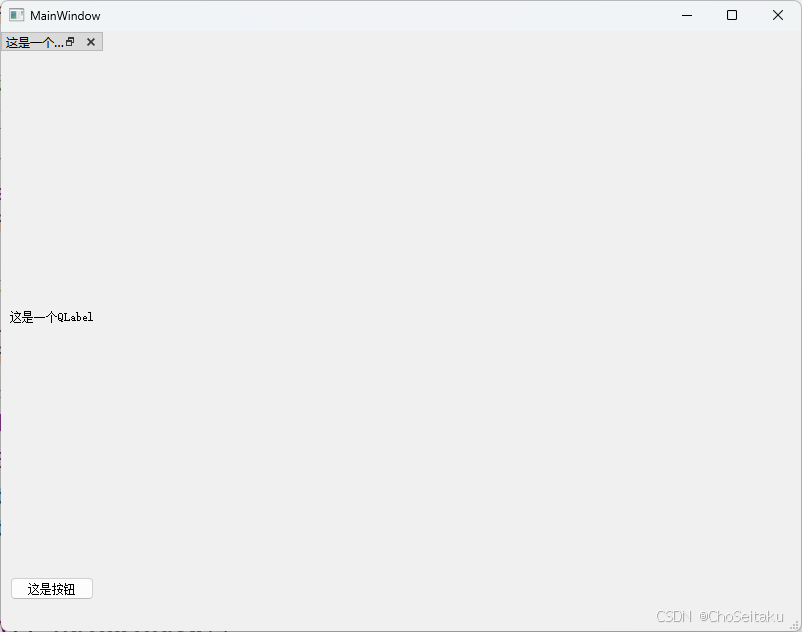
c++
//设置浮动窗口允许停靠位置
dockWidget->setAllowedAreas(Qt::LeftDockWidgetArea | Qt::TopDockWidgetArea);